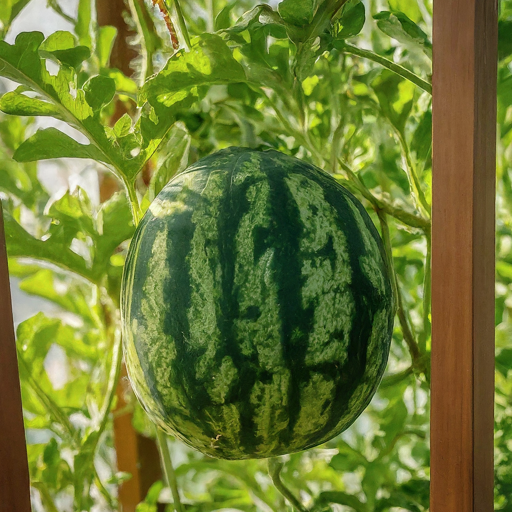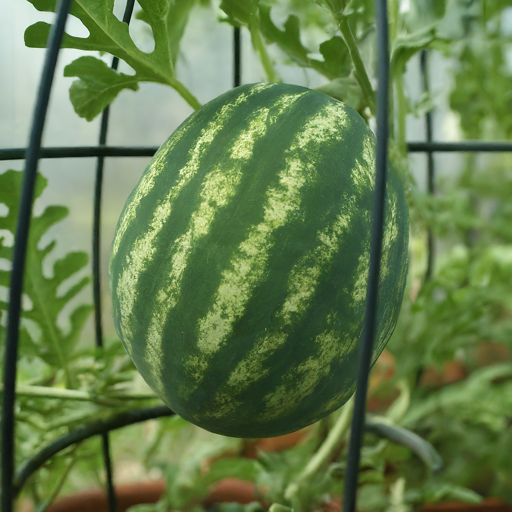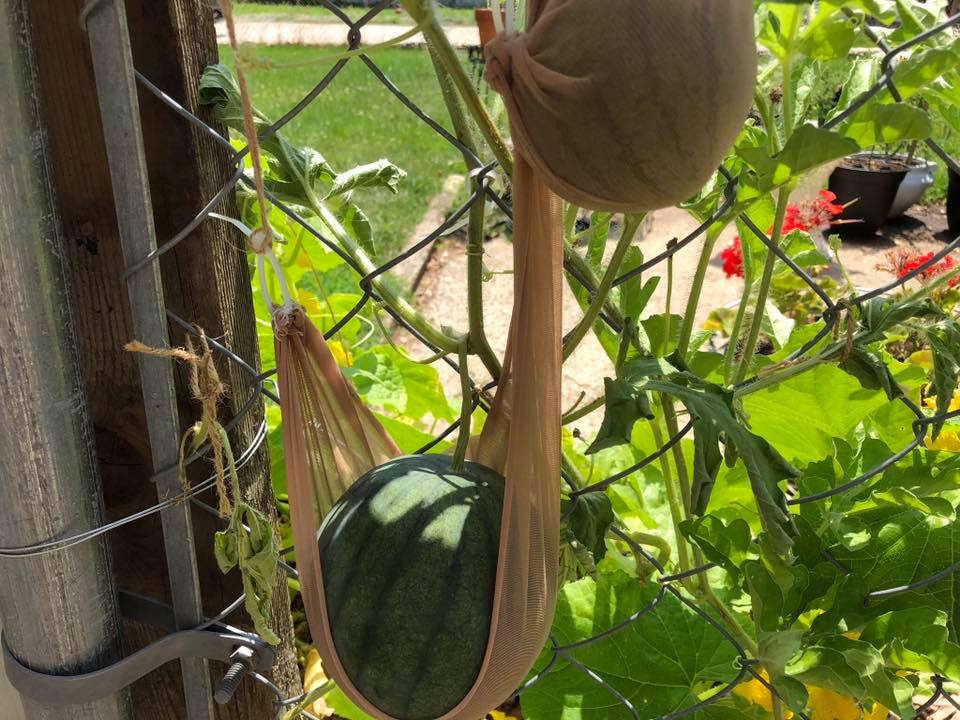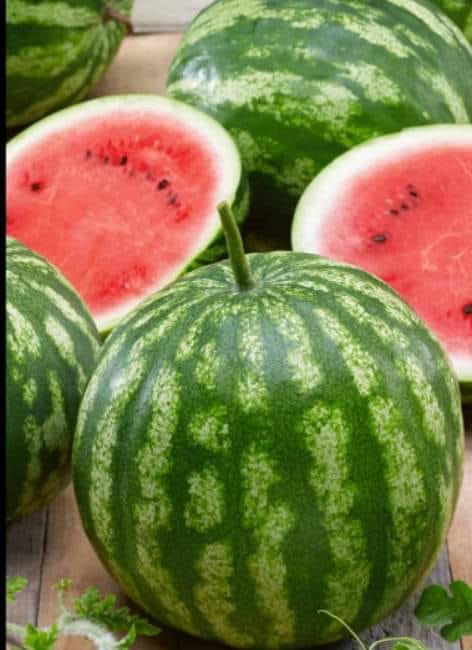
This post may have affiliate links. This means that sometimes when you click a link on our site and make a purchase on Amazon, we may earn a small commission at no additional cost to you. We only recommend products we truly believe in, and your support helps keep us running!
For those with limited space or a yearning for a unique gardening experience, the secret lies not in the soil beneath your feet, but in the skyward sprawl above. Vertical watermelon growing is a method that utilizes trellises, cages, or other support structures to coax these favorite summer fruits upwards, maximizing yield and transforming your garden into a whimsical, green tapestry. So, ditch the sprawling vines and embrace the vertical vine – it’s time to save space and score big, juicy watermelons!
Why Go Vertical with Your Watermelons?
There are several compelling reasons to consider this innovative approach to watermelon cultivation:
- Space Efficiency: Watermelon vines, notorious for their sprawling nature, can quickly engulf a garden. Vertical growing allows you to cultivate multiple melons in a fraction of the space, making it ideal for patios, balconies, or even small backyards.
- Improved Air Circulation: Vertical trellises promote better air circulation around the fruits, reducing the risk of fungal diseases that thrive in damp environments. This translates to healthier melons and potentially higher yields.
- Easier Maintenance: Elevated vines make it a breeze to inspect your watermelons for pests or signs of disease. Additionally, weeding becomes a much less backbreaking chore.
- Aesthetics: A vertical watermelon patch is a conversation starter! The cascading vines laden with vibrant green melons create a visually stunning addition to any garden.
Gearing Up for Your Vertical Adventure

Before embarking on your skyward watermelon journey, a little preparation goes a long way. Here’s what you’ll need:
- Seeds: Opt for varieties known to thrive in vertical settings. Bush or compact watermelons, like ‘Bush Sugar Baby’ or ‘Crimson Sweet’, are excellent choices. These varieties produce smaller, yet equally delicious, fruits that are perfect for vertical growing.
- Support Structure: The sturdiness of your support system is crucial. Trellises made from strong metal, PVC pipes, or even repurposed fencing can work well. If you have a sturdy fence or railing, you can utilize that as well. The key is to ensure your chosen structure can handle the weight of mature watermelons.
- Growing Medium: You have options! You can either use large pots filled with high-quality potting mix or opt for a soilless growing system like a fabric grow bag. Whichever method you choose, ensure the container has ample drainage holes to prevent waterlogging.
- Additional Supplies: Heavy-duty plant ties, a sharp knife or pruners, and a water meter will come in handy throughout the growing season.
Planting and Nurturing Your Vertical Climbers

Now that you’re armed with the essentials, let’s get planting!
- Sowing the Seeds: Follow the recommended seed spacing on the seed packet. If using a pot, plant two to three seeds per container, thinning to the strongest seedling once they emerge. For a soilless grow bag, plant seeds directly in the bag.
- Supporting Your Seedlings: As your seedlings develop their first true leaves, gently guide them to climb the support structure using plant ties. Choose a loose tie that allows for some stem movement as the plant grows.
- Training and Pruning: Once your watermelon vine reaches a manageable height (around 12-18 inches), it’s time for some gentle training. Pinch off any excess side shoots that appear below where you plan to develop the main fruit. This encourages the plant to focus its energy on producing one or two large melons instead of many smaller ones. As the vine continues to grow, continue to tie it loosely to the support structure, ensuring good air circulation around the developing fruit.
Watering, Feeding, and Sunshine for Success
Just like any other plant, your vertical watermelons need proper care to thrive:
- Watering: Watermelon vines are thirsty, especially during the hot summer months. Aim for consistent moisture in the growing medium, but avoid waterlogging. Use a water meter to gauge moisture levels and adjust your watering schedule accordingly.
- Feeding: Watermelons are heavy feeders. Fertilize your plants with a balanced fertilizer formulated for fruiting vegetables, following the instructions on the package. A slow-release fertilizer can be particularly beneficial for maintaining consistent nutrient levels.
- Sunshine: Watermelons crave sunshine! Aim for at least 8 hours of direct sunlight per day for optimal growth and fruit production. If your balcony or patio receives limited sunlight, this might not be the ideal method for you.
Pollination Power: A Helping Hand for Bountiful Yields
Watermelon plants are monoecious, meaning they produce separate male and female flowers on the same vine. However, pollination can sometimes be less efficient in a vertical setup due to the altered flower positioning. Here’s how you can give your vertical watermelons a helping hand:
- Bee on the Lookout: Attract pollinators like bees and butterflies to your garden by planting flowering herbs or companion flowers near your watermelon plants. These colorful additions will not only beautify your vertical garden but also encourage natural pollination.
- Hand Pollination: If natural pollination seems sluggish, you can take matters into your own hands. Identify the male flowers (they have a single stamen) and the female flowers (they have a small ovary at the base of the flower). Using a soft brush or cotton swab, gently collect pollen from a male flower and dab it onto the stigma (the sticky part) of a female flower. Repeat this process for several female flowers to increase your chances of successful fruit set.
The Sweet Reward: Harvesting Your Vertical Bounty

Patience is a virtue, especially when it comes to watermelons. Most varieties take around 70-80 days to mature from seed to harvest. Here are some signs that your vertical watermelons are ready to be enjoyed:
- The Tendril Test: The delicate tendrils near the base of the watermelon stem will begin to brown and dry out when the fruit is ripe. Give the watermelon a gentle tug; if it easily detaches from the vine, it’s harvest time!
- A Thump on the Thump Meter: Give your watermelon a gentle thump. A ripe watermelon will have a dull, hollow sound. Unripe melons will sound firmer with a higher-pitched thump.
- The Weight of the World: Mature watermelons will feel heavy for their size. This is a good indicator that the fruit is full of juicy goodness.
Once you’ve confirmed ripeness, use a sharp knife to carefully sever the watermelon from the vine, leaving a short stem attached. Congratulations! You’ve successfully cultivated a delicious watermelon using the vertical method.
Beyond the Harvest: Keeping the Vertical Adventure Going
With proper care, your vertical watermelon support structure can continue to be a productive haven for future harvests. Here’s how to keep the vertical vine thriving:
- Post-Harvest Maintenance: Once you’ve harvested your watermelons, remove any spent vines and leaves from the support structure. Clean the structure with a mild disinfectant to prevent the spread of disease.
- Overwintering Considerations: Depending on your climate, you might be able to overwinter your watermelon support structure for use in the following season. If your winters are harsh, it’s best to disassemble the structure and store it indoors in a cool, dry location.
- Next Season’s Planning: Replenish the potting mix in your containers or replace your grow bag with fresh medium. Plan your next vertical watermelon adventure, perhaps trying a new variety or incorporating additional companion plants for a more visually captivating display.
Vertical watermelon growing is a rewarding and space-saving way to enjoy these summer favorites. Embrace the challenge, witness the magic of skyward vines, and savor the sweet reward of your vertical gardening success!
